#tavistock books
Explore tagged Tumblr posts
Text

D.W. Winnicott - Playing & Reality - Tavistock - 1971 (cover by J. Hayward)
#witches#players#occult#vintage#tavistock books#tavistock#playing & reality#d.w. winnicott#donald woods winnicott#j. hayward#1971
24 notes
·
View notes
Text
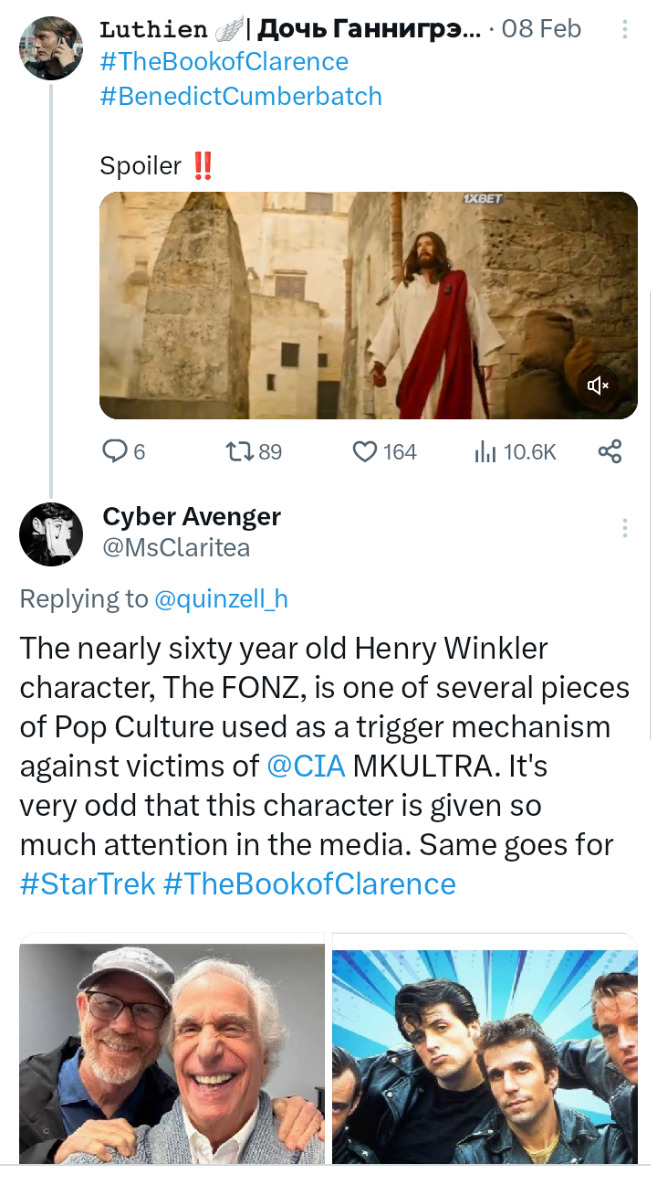
I remember Happy Days very clearly. It was a funny show. It was not epic cinema. Yet, Henry Winkler gets a regular round of random guest spots and interviews. Most people don't remember Happy Days. It's dated like a lot of stuff from that era. Articles state that actor, Benedict Cumberbatch was instructed to 'behave like Fonzie'. Why? That character is kept alive by Hollywood, not the general public. It makes no sense, how much time and energy they spend, doing it, unless there's another reason, because there's more news about a sixty year old show than there is the Oscars.
#Jeymes Samuel#Jay Z#The Book of Clarence#MKULTRA TRIGGERS#Star Trek#The Fonzie#Happy Days#Colors#Sounds#Songs#Bluebird#Henry Winkler#Tavistock#Paramount Global#Cult of Scientology#National Football League#Silicon Valley#Sports Betting#Taylor Swift#Travis Kelce#AntiChristian#Race-Baiting#Benedict Cumberbatch#NFL
2 notes
·
View notes
Text
can’t sleep and i’m entirely blaming tanya tavistock after being unfortunately reminded of her existence
It wasn’t fair for Tanya Tavistock to have been put in this position of having to decide whether or not to ruin all these passengers’ day, and it was other people who had put her here- dumb people, hateful people, people who had no love of life and should just put themselves out of their own misery in private and jump off Waterloo Bridge or something, rather than dragging a bunch of strangers into their cult of suicide, too. Wasn’t life hard enough, without having to worry about being deliberately run over by a lorry while walking the dog, or being deliberately incinerated en route to the airport? If you don’t like it on this planet, get off. Depart your wretched mortal coil. Leave life to the rest of us, who have our own problems, believe it or not, without being saddled with yours.
she’s actually insane
#i hate that i have this like partially memorised#but actually what the fuck was this you look at the reviews of the book and there’s just nothing about her#and i get it it’s speaking from the perspective of a character and therefore you say some fucked up things sometimes but this is#this is just fucking weird man#and also why does it change person mid way through??#cause it’s all third person and then suddenly it’s we and us#bitch who is we who else things depressed people should just kill themselves?? who is agreeing with you??#i think that’s my issue cause it makes it look like it’s from the author rather than TT herself#overall pretty weird story anyway#i’m like slightly losing my mind i don’t know why i can’t sleep i am fucking exhausted but also not at all apparently!!#i should really be over Tanya Tavistock cause that was like 6 months ago now but i’m still fucking perplexed#who the fuck is dragging strangers down into a cult of suicide bestie#this is such a rational rambling i literally don’t know what i’m saying but i am conscious of it#idk if this is silly hours or not it probably is but it doesn’t feel usual#somehow it’s been a week since last week which is just#uh if i actually post this i apologise i don’t quite no why this has happened#tw sui talk#<- just in case this spreads beyond like 3 people#only one of whom knowing what the fuck i’m talking about (hello!)
1 note
·
View note
Text
Check out the book from @BlurbBooks: : LOVE
#Tavistock_Devon_First #LGBTQIA + Gay Pride Event
2022
Part 4
0 notes
Text
Good Omens filming locations masterpost! ❤ 🐍😊 Part 1
I made a Google map containing all the locations, see here! :)
Part one contains Season One, continue here for part 2 and here for part 3 containing the rest of S1 and Season Two, also a bonus book mausoleum!!! (it is split into more parts because tumblr has a limit of images in one post :))
SEASON 1
London:
AC in Berkeley Square (S01E06) - Tavistock Square, London

Scene: AC swap back and decision to go to The Ritz
Availability (as of 2024): 7:30–21
Link on the map
Crowley in the pub (S01E05) – The Enterprise pub, London
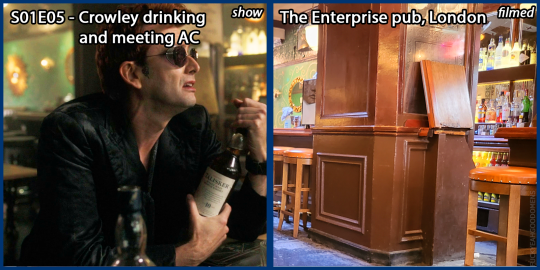
Scene: Crowley drinking and meeting not quite corporal Aziraphale
Availability (as of 2024): Mon-Wed 12-23, Wed-Sat 12-24, Sun closed
Link on the map
Crowley on the way to the burning bookshop (S01E05) – Wardour Street, London

Scene: Crowley's Bentley rushing throught the streets of London
Availability (as of 2024): street all day
Link on the map
AC on the bus (S01E01) - Piccadilly Circus, London

Scene: Aziraphale and Crowley meet on the bus to discuss the antichrist, in the background the Piccadily Circus can be seen
Availability (as of 2024): street all day
Link on the map
AC at The Ritz (S01E01, S01E06) - Criterion, London
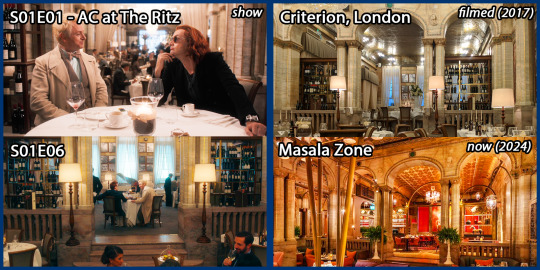
Scene: Aziraphale and Crowley at The Ritz in the first and sixth episode of the first season. It was actually filmed at the Criterion restaurant which since then has unfortunately been closed and now (2024) there is Masala Zone with unfortunately changed interier :(.
Availability (as of 2024): Mon to Thur 12:00-22:30, Fri 12:00-23:00, Sat 12:30-23:00, Sun 12:30-22:30
Link on the map
AC on the way to the manor (S01E02) – Whitehall street, London
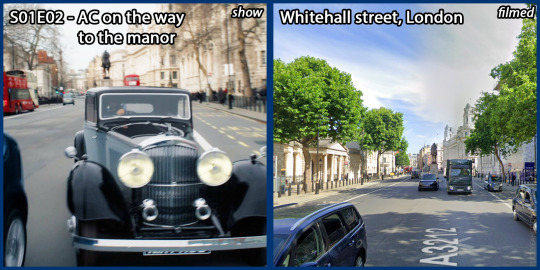
Scene: Crowley with Aziraphale driving the Bentley to the Tadfield manor
Availability (as of 2024): street all day
Link on the map
AC leaving the St James's Park (S01E01) - Carlton House Terrace, London

Scene: The stars on which Aziraphale and Crowley leave St James's Park in Episode 1, Crowley tempts Aziraphale to lunch and they speed away
Availability (as of 2024): street all day
Link on the map
AC meeting in St James's Park (S01E01, S01E03, S01E06) - St James's Park, London
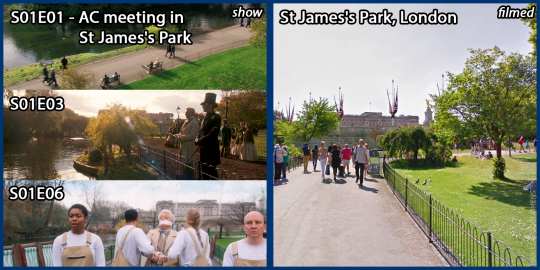
Scene: Aziraphale and Crowley's meeting in St James's Park by the ducks in the first season in episode one (about the antichrist), episode three (victorian scene) and episode six (the kidnapping)
Availability (as of 2024): 5-24
Link on the map
Newt meeting Shadwell (S01E02) – Between Westminster Abbey and Palace of Westminster, London
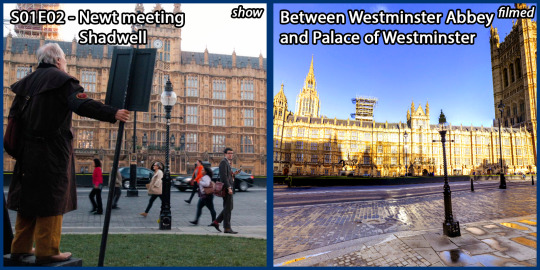
Scene: Newt meets Shadwell for the first time
Availability (as of 2024): street all day
Link on the map
The Bandstand scene in St James's Park (S01E03) – Battersea Park, London

Scene: The bandstand scene in season one.
Availability (as of 2024): 8am until dusk
Link on the map
Aziraphale stops Gabriel during his jogging (S01E04) - Battersea Park, London
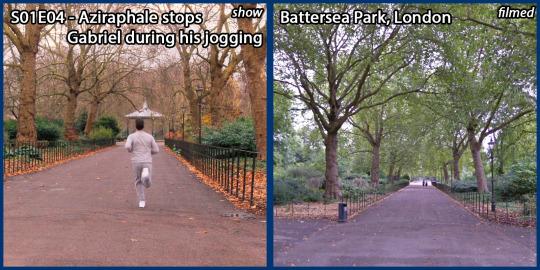
Scene: Aziraphale stops Gabriel during the jogging.
Availability (as of 2024): 8am until dusk
Link on the map
'Crowley' outside his flat (S01E06) - Eastfields Avenue, London

Scene: The morning after the Apocaflop 'Crowley' coming out from his flat.
Availability (as of 2024): street all day
Link on the map
Dirty Donkey in 1967 (S01E03) - The Cat's Back pub, London

Scene: The interior of Dirty Donkey from 1967 where Crowley meets Shadwell for the first time has been filmed in The Cat's Back pub (the interior has been transformed into the 60s)
Availability (as of 2024): Mon - Closed, Tues: 5pm - 11pm, Wed - Thu: 4pm - 12am, Fri: 4pm - 1am, Sat: 2pm - 1am, Sun: 1pm - 11pm
Link on the map
Shadwell reports to Crowley (S01E03) – Best Cafe, London
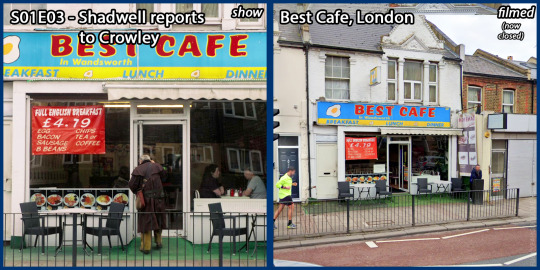
Scene: Shadwell meeting Crowley in the present time.
Availability (as of 2024): street all day, the establishment itself seems closed now :(
Link on the map
AC talking about the Warlock's birthday party (S01E01) - Crystal Palace Park, London
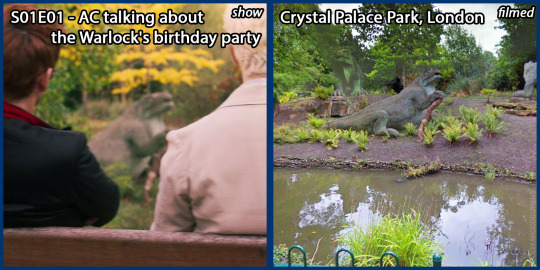
Scene: Aziraphale and Crowley watching Warlock in the park with dinosaurs and talking about the birthday party
Availability (as of 2024): 7:30am - sunset
Link on the map
AC stopping in a cafe after the manor (S01E02) – Penge Cafe (then) / Antonella's Cafe and Bistro (now), London
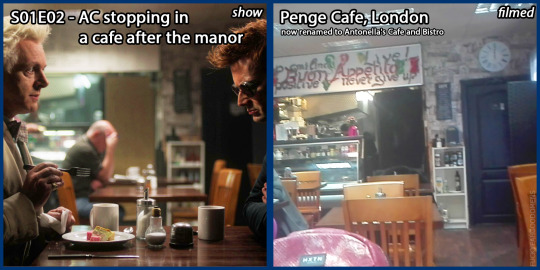
Scene: Aziraphale and Crowley stopping to discuss how to find the antichrist after visiting the Tadfield manor, at the time of the shooting it was named Penge Cafe, now renamed to Antonella's Cafe and Bistro
Availability (as of 2024): Wed-Sat 8:30-5, Sun: 9-5
Link on the map
AC watching Hamlet in 1601 (S01E03) – Shakespeare's Globe, London

Scene: Aziraphale and Crowley secret meeting in 1601 during a Hamlet performance
Availability (as of 2024): They open at specific times for tours and performances. See performances and tours on www.shakespearesglobe.com/whats-on/, for example 3 APRIL - 23 OCTOBER there's a 'Pride Guided Tour bringing to life the queer stories and characters from Shakespeare’s life and times.' :). https://www.shakespearesglobe.com/whats-on/guided-tour-pride/
Link on the map
Crowley after bringing down the phone network (deleted scene, DVD) – Trinity Church Square, London
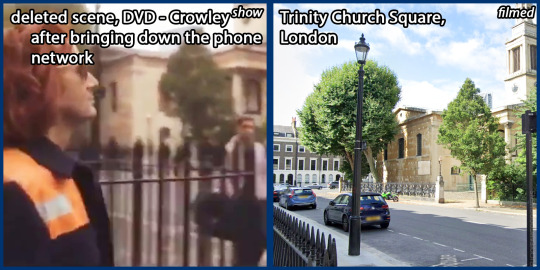
Scene: Crowley leaving after he brings down the mobile phone network in the BT Tower
Availability (as of 2024): street all day
Link on the map
Heaven top floor (S01E04, S01E06) – Sky Garden, London

Scene: The Heaven top floor background windows were filmed in Sky Garden, we are seeing this at the scene where Michael shows Gabriel the Earth Observation Files and during Aziraphale's execution (though the scene itself seems to be filmed with green screen)
Availability (as of 2024): the access is free but needs to be booked beforehand at https://skygarden.london/
Link on the map
Stairs To Heaven and Hell (S01E01) – The Broadgate Tower, London

Scene: Aziraphale and Crowley go to Heaven and Hell through the staircase
Availability (as of 2024): The tower is open Mon-Fri 9-18 but there is a reception downstairs where these stairs are – I've visited twice and once they were okay with me taking picks of the stairs and once not. The stairs are thought well visible from the outside and pics can be taken that way.
Link on the map
Aziraphale, Tracy and Shadwell on a scooter (S01E05) - Cardwell Road, London

Scene: Aziraphale miracles Tracy's scooter to fly with them and Shadwell to Tadfield
Availability (as of 2024): street all day
Link on the map
Where Shadwell and Madame Tracy live (S01E02, S01E04, S01E05) - Hornsey Road, London
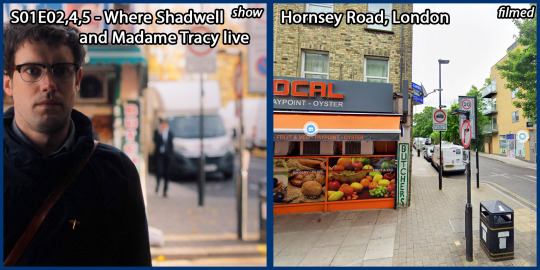
Scene: The residence of Shadwell and Madame Tracy. We see it in episode two (Newt arrives), episode four (Newt leaves for Tadfield) and episode five (shaken Shadwell arrives, customers for the seance arrive)
Availability (as of 2024): street all day
Link on the map
Aziraphale eating sushi (S01E01) - Red 'N' Hot (closed), London
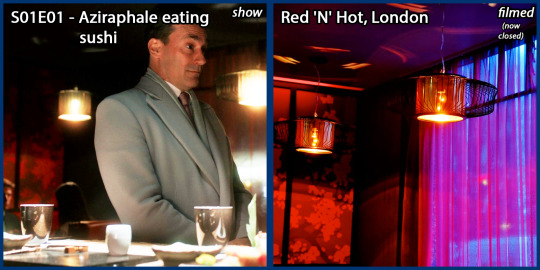
Scene: Aziraphale eating sushi with a surprise visit from Gabriel
Availability (as of 2024): It was filmed in the Red 'N' Hot – a sichuan restaurant, but it has been closed (now there is another restaurant with different interior)
Link on the map
Some scenes has also been filmed in the West London Film Studios.
Hambleden:
Hambleden is the place where most of the Tadfield village was shot :).
Tadfield Square (S01E01, S01E03, S01E05, S01E06) – Square in front of the church, Hambleden

Scene: Crowley phoning Aziraphale to tell him about the Armageddon in episode one, Adam reading and Anathema with R.P. Tyler in episode 3, seen R.P. Tyler meeting those going to the airfield in episode 5 and Aziraphale and Crowley are drinking on a bench after the Apocaflop and waiting for the bus
Availability (as of 2024): street all day
Link on the map
Adam's house (S01E02 , S01E03, S01E06) - Hambleden

Scene: Adam Young's house (can be seen in several episodes)
Availability (as of 2024): street all day
Link on the map
The Them buying ice-cream (S01E02) – Hambleden convenience store, Hambleden

Scene: The store that The Them bough ice-cream from
Availability (as of 2024): Street all day, the store Mon-Sat 8-17, Sun 8-16:30
Link on the map
The Them planning to stop Armageddon (S01E05) - Hambleden
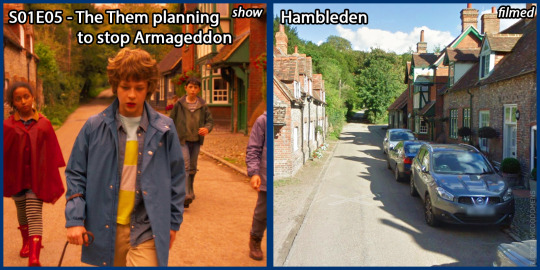
Scene: The Them returning planning to go to airfield and stop Armaggedon
Availability (as of 2024): street all day
Link on the map
Anathema's cottage (S01E02, S01E03, S01E04) – cca 2km from the Hambledon square

Scene: The scenes with Anathema's cottage (Jasmine Cottage) were filmed here, it can be seen several times throughout the series (like Anathema moving in, AC dropping her off or Adam visiting her)
Availability (as of 2024): street all day
Link on the map
Others in England:
Warlock's house (S01E01) – High Canons, Borehamwood

Scene: The Warlock's home was filmed at the High Canons Estate which is listed on National Heritage List for England
Availability (as of 2024): The High Canons Estate is currently privately owned and not open to public, the house is not visible from road.
Link on the map
Hastur and Ligur hand over the Antichrist (S01E01) – Holy Trinity Church, Penn Street
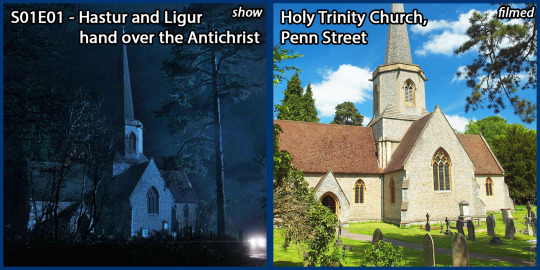
Scene: Hastur and Ligur give Crowley the Antichrist at the graveyard
Availability (as of 2024): the outside should be available all day
Link on the map
(continue to Part 2 :))
1K notes
·
View notes
Text
maybe it's just the news about the ban on puberty blockers, or the renewed coverage of brianna ghey's murder, but i can't help feeling like transphobia in the uk is gaining traction every day. it feels genuinely unsafe to be trans here and while i'm not in fear for my life, i cannot escape the sense that i am living in a world that is fundamentally hostile towards me and people like me. and it's not getting better. it's getting worse.
for months i worked at one of london's biggest bookstores, where i was told to display authors like kathleen stock and helen joyce and abigail shrier as face-outs because they were so popular. i had to smile and make small talk while ringing up these books. i didn't complain about this. what would be the point? people want those books, so we sell them. that's what bookshops are for. you can't just not sell books because you don't agree with what's in them. so i didn't complain about it.
the number of trans hate crimes has hit a record high. the tavistock's young adult department has shut down. the wait to be seen at a gender clinic is now ten years and counting. and yet i still have to read articles in mainstream leftist newspapers that talk about how there should be more restrictions placed upon us, or how the mere fact of our existence is endangering children. of course you can't complain about this either. last week i had an appointment with a cis doctor who used the correct pronouns for me and expressed sympathy for my struggles with the NHS, and even that was enough to almost bring me to tears, because i'm so used to doctors treating me with suspicion or discomfort that even the bare minimum feels like a gift.
you can't complain about it. other trans people already know how it is, so there's no point in telling them, and cis people don't care. what good do words do if nobody's listening?
#whenever i see a uk article online about a trans-related issue i have to force myself not to read the comments#because i know the vast majority will be hateful vitriol#it's just exhausting#transphobia#be shh now#vent post
281 notes
·
View notes
Photo

This was just such a downbeat book - and quite macabre. I'm not surprised the staff displayed it prominently, it's an absolute conversation stopper, I reckon.
In the Sue Ryder charity shop, in Tavistock, UK.
171 notes
·
View notes
Text
There's something satisfying about when an abusive man is called out by other men. Or at least one man.
Rest In Infamy, You Haunted Castle
Why I believe the Neil Gaiman accusations
By GRAHAM LINEHAN JUL 19, 2024
I only met Neil Gaiman once, at an upscale dinner party where Derren Brown had been hired to do magic tricks like in the old-timey days. Between astonishments, Gaiman and I withdrew to a quiet corner where I pretended to be pleased that he was giving me a signed copy of ‘Sandman’. One of the unexpected advantages of being cancelled is telling people who took part in my harassment what I really think about their work, but this was a long time ago, in a galaxy far, far away, so I said the right things and we went back to being bamboozled by Brown’s invisible craft.
To give credit where it’s due, I later read Gaiman’s ‘Coraline’ to my kids which had them simultaneously terrified and hooked, and thanked him for it. Whatever my feelings about his earlier work, he was a real writer, practising his own invisible craft. From the evidence of that book, I thought he was probably a decent person too, an impression that continued until 2022, when we started to get into it over The Issue.
I may have asked why he wasn’t speaking out on behalf of JK Rowling, who was undergoing one of her regular cancellations for refusing to pander to the spoilt brats who loved her books but missed their meaning. A big name like his might have shifted the conversation and given her some much-needed support. He might perhaps have persuaded some of his fans to give the matter another look. This was when I assumed people like him acknowledged biological reality but worried about ‘coming out of the closet’, as it were. It took me years to realise that almost every celebrity mate of mine believed, or was pretending to believe, in the fashionable, American mind-cancer of ’gender’.
But back then, I was still astonished to find that he was a carrier of the virus, the mass delusion that by sheer coincidence, turned up after the arrival of the Internet. Whether it was Bill Bailey or Neil Hannon, Robin Ince or Matt Lucas, Arthur Mathews or Jimmy Mulville, it was always the same story. A sudden cloud of amnesia would form around my celebrity mates, a real peasouper, from which they suddenly could not see why we need female-only spaces, or why unhappy teenage girls will not find a miraculous cure for their woes in a double mastectomy. Far from sharing any of my urgency in the need to stop children from being irreversibly harmed in gender clinics, they instead downplayed, deflected and dismissed. “I never ask you to join in with my animal activism” grumbled Neil Hannon on one of the occasions I begged for his support.
“Couldn’t you pretend women and children are animals?” I thought.
My usual trajectory during these conversations saw me shifting from gobsmacked disbelief to fury and despair. The disloyalty made me angry, but knowing my friends did not care about their own daughters, wives, sisters and mothers was, and continues to be, destabilising in the extreme.
Gaiman went one step further. I can’t find the tweet, so I may be paraphrasing, but he said
"I hope you're kinder if your daughter ever hopes to transition."
I can think of no uglier thing to say to a parent. For girls, ‘transition’ means double mastectomies in their teens, hysterectomies in their mid-twenties, early menopause and a four times greater chance of having a heart attack than males of the same age. To have this decaying goth wish that horror on my daughter was more than I could bear. I wanted to rip his throat out.
Like a pair of grappling cowboys falling off a rooftop, our fight spilled into email. I sent Gaiman this article about the Tavistock. It was clear when he wrote back that he hadn’t absorbed it Like most celebrities in this fight, he appeared to have lost the ability to read.

“As I said before Graham, I hope that you'd be kinder if it was one of your kids who wanted to transition. “
He actually said it again. The piece was right there, detailing exactly what was happening to the children unlucky enough to wander through the Tavistock’s doors, and he chose to repeat that disgusting thing. Why?
That same year, just months before Gaiman was advising me on the value of kindness, a 22-year-old woman (‘Scarlett’ in the podcast) arrived at his Waiheke Island home in New Zealand for a babysitting job. Upon her arrival, she discovered that Gaiman’s wife of the time, Amanda Palmer, had suddenly remembered a sleepover, an appointment the child was apparently eager to attend.
So she and junior drove out of view, leaving the 23 -year-old Scarlett alone with Gaiman for the night. Within a few hours the 61-year-old man, without warning or invitation, appeared fully naked and slipped into the other end of her bath. Scarlett alleges that over the next three weeks, they embarked on a semi-consensual relationship, where Gaiman routinely ignored the boundaries she set. She alleges that he became angry when she would refuse these demands, used a belt to beat her, insisted she call him ‘Master’ and once sexually assaulted her so violently that she lost consciousness.
“… (the sex) was so painful and so violent that I fainted. I passed out, lost consciousness, ringing in the ears, black vision, the pain was celestial, you know, which is a strange word to use, but I couldn't even describe it in language. And when I regained consciousness and I was on the ground, I looked up and he was watching the rehearsals from Scotland of whatever they were filming, I don't fucking know. And he didn't even notice that I was passed out. And you know…there was blood. It was so so, so traumatic, and I asked him to stop. I said it was too much.”
Scarlett is a compelling witness despite, or because of, her contradictions. Certain things paint a picture of consent—she sexted Gaiman, to which he would send careful replies—and she laughs nervously when she talks about the alleged abuse. But when Gaiman’s side of the story is put to her, she turns cold as a knife and shows flashes of fury that she—in her telling—young, inexperienced and dazzled by Palmer and Gaiman’s fame and lifestyle, was used so casually and so brutally.
A few years back, I wrote about becoming a sort of Jessica Fletcher figure on Twitter. ‘Murder, She Wrote” but with paedophiles and predators. “Just as murderers seemed drawn to any location Jessica presented herself, “ I said. “My opining about women's rights and safety on Twitter appeared to attract the kind of men who can't sit still during a spelling bee.”

Among my adversaries was Peter Bright, the Ars Technica writer now doing twelve years for trying to buy two children to abuse. Luckily the children didn’t exist and the parents were actually FBI agents. Our exchange was brief and concerned safeguarding. I’m sure you’re all astonished to discover that he was against it.
Then there was ex-Labour MP Eric Joyce, who argued with me about the safety of mixed-sex loos in schools and was done for possessing the worst kind of child abuse images. More recently, I tangled with ‘Lexi’, who is now serving time for rape.
They all had one thing in common. They couldn’t leave alone those of us who were actively opposing the trans movement's assault on safeguarding, an assault that chimed nicely with their plans for the future. Each was returning to the scene of a crime not yet committed, each picking at a scab on their own character.
In 2018, at the height of #MeToo, Gaiman tweeted “On a day like today it’s worth saying, I believe survivors. Men must not close their eyes and minds to what happens to women in this world. We must fight, alongside them, for them to be believed, at the ballot box, and with art, and by listening, and change this world for the better.”
Well said. I certainly believe the women in ‘Master’. During my Jessica Fletcher period (a period which continues) no-one except Gaiman ever mentioned my kids. I think he knew it would cause me distress, and the second time he said it was just a twisting of the knife. Many of my colleagues in the media joined in with the trashing of my reputation, but Gaiman went that extra mile. I believe this is because he is a sadist. I think he is a man who finds pleasure in the suffering of others, and a man who does not see women and girls as fully human.
This was my final letter to him.
Dear Neil
I notice you’re still pretending you can’t read the Tavistock story. If you ever try and lay that curse on my kids again I will certainly share our exchange. Your privileged beliefs are harming children so to paraphrase Will Smith, keep their names out of your fucking mouth.
Thank you for giving me one last chance to say that JK Rowling will be remembered as a hero and you as a traitor to the kids who loved your books.
Rest in infamy, you haunted castle.
All the best,
Graham.
#Rest In infamy neil gaiman#Graham Lineham is speaking the truth#Neil Hannon commpared campaigning for women's rights to animal activitism#Neil gaiman refused to stand up for JKRowling#Neil gaiman allegedly became angry when the 23 year o.d woman would refuse the demands of the 61 year old#Neil gaiman allegedly used a belt to beat her#Neil gaiman allegedly insisted she call him ‘Master’ and once sexually assaulted her so violently that she lost consciousness.#Peter Bright is the Ars Technica writer now doing twelve years for trying to buy two children to abuse#Ex_Labour MP Eric Joyce who argued with me about the safety of mixed-sex loos in schools possessed the worst kind of child abuse images#Neil Gaiman dragged Linehams kids into their conversations#Neil gaiman used the gender cult for his own image yet attacked two biological women
86 notes
·
View notes
Text
please go to a protest for Land Day tomorrow (March 30th) if you can

AUSTRALIA – Hobart / Nipaluna. 1PM Every Saturday @ Davey St. (Grand Chancellor).
CANADA – Antigonish, NS. 1PM Every Saturday @ Antigonish Town Hall. Antigonish 4 Gaza.
CANADA – Montreal. 2PM Land Day Tatreez Workshop @ Refugee Center. PYM Montreal.
CANADA – Ottawa. 2PM Land Day @ Human Rights Monument.
CANADA – Toronto. 2PM Land Day @ Yonge & Dundas. PYM Toronto.
ENGLAND – Halifax. 1PM Every Saturday @ Wilkos on Southgate.
ENGLAND – Hebden Bridge. 3PM Every Saturday @ Holme Street. 4PM @ St George’s Square. West Yorkshire for Palestine.
ENGLAND – London. 11AM @ 7 Tavistock Square. PYM Britain.
ENGLAND – London. 12PM @ Central London. STW UK.
NETHERLANDS – Amsterdam. 7PM Every Night @ Dam Square.
PORTUGAL – Porto. 10PM Every Night Vigil @ Camara Municipal.
SCOTLAND – Orkney. 1PM Every Saturday @ St Magnus Cathedral Steps. Amnesty Orkney.
AZ – Phoenix. 1MP Land Day @ Civic Space Park. PSL Phoenix AZ.
CA – Los Angeles. 1PM Land Day March @ LA City Hall. PYM LA/OC/IE.
CA – Petaluma. 12:30PM Every Saturday @ Petaluma & E Washington. Occupy Pelatuma.
CA – Ventura. 12:30PM @ 181 E Santa Clara St. ANSWER Coalition.
CO – Fort Collins. 3PM Every Saturday @ Old Town Square. NOCO Liberation Coalition.
DC – Washington DC. 4PM @ DuPont Circle. ANSWER Coalition.
FL – Gainesville. 11AM @ Depot Park. ANSWER Coalition.
FL – Orlando. City Hall. TBA. ANSWER Coalition.
FL – Pensacola. PM @ Main & Reus (Blue Wahoos). PSL CGC.
GA – Atlanta. 2PM @ Consulate of Israel. PYM.
ID – Pocatello. 12PM Every Saturday @ Bannock County Courthouse. Pocatello for Palestine.
IL – Chicago. 1PM @ TBA. USPCN + Chicago SJP.
LA – New Orleans. 3:30PM @ 701 N Rampart St.
MA – Springfield. 2PM @ 36 Court St. ANSWER Coalition.
ME – Portland. 1PM @ Monument Square. PSL Maine.
MI – Detroit. 1:30PM @ Beacon Park. USPCN.
MI – Detroit. 10AM Land Day @ Rouge Park. PYM.
MN – Minneapolis. 2PM @ 2707 West Lake St. ANSWER Coalition.
MT – Kalispell. 12PM Every Saturday @ Main & Center. MT 4 Palestine.
NC – Asheville. 4PM @ 1 N Pack Square. ANSWER Coalition.
NC – Charlotte. 4PM @ Wilmore Centennial Park. CLT 4 Palestine + PSL Carolinas.
NC – Raleigh. 3PM Land Day @ Moore Square. PSL Carolinas.
NC, Charlotte. 4PM @ Wilmore Centennial Park. Land Day. CLT 4 Pali + PSL Carolinas.
NM – Albuquerque. 4PM @ UNM Book Store. ANSWER Coalition.
NY – New York. 12PM @ City Hall Park. Within Our Lifetime.
NY – New York. 12PM Vigil Every Saturday @ 5th & 44th in Brooklyn. Sunset Park Elders.
NY – New York. 5PM @ Times Square. PYM.
NY – Rochester. 1:30PM @ MLK Park. End Apartheid ROC + SJP UR.
OH – Cincinnati. 3PM @ 801 Plum St. ANSWER Coalition.
OH – Cleveland. 2PM Land Day @ Edgewater Upper Pavillion. USCPN.
OH – Columbus. 4PM @ 120 W Goodale St. ANSWER Coalition.
OH – Dayton. 5PM @ 2680 Ridge Ave. ANSWER Coalition.
OH – Wooster. 11AM @ 538 N Market St. ANSWER Coalition.
OR – Bend. 12PM Saturdays @ Peace Corner. Central Oregon 4 Socialism.
OR – Portland. 12PM @ Desert Island Studios. Letters for Palestine PDX.
PA – Philadelphia. 5PM @ 7th & Walnut. ANSWER Coalition.
PA – Pittsburgh. 3:30PM @ 4100 Forbes Ave. ANSWER Coalition.
RI – Providence. 5PM @ Prospect Terr. ANSWER Coalition.
TX – Houston. 1PM @ Waterwall Park. PYM Houston.
TX – San Antonio. 12PM @ 301 E Travis ST. ANSWER Coalition.
VT – Burlington. 1PM @ City Hall. ANSWER Coalition.
WA – Seattle. 2PM Land Day @ Lake Union Park. PYM.
WI – Milwaukee. 1:30PM @ Sijan Park. PSL Milwaukee.
WI – Viroqua. 11AM Vigil Every Saturday @ Main & Decker. Driftless Solidarity / Wolves PSC.
WV – Martinsburg. 12PM Land Day @ Martinsburg Town Square. PSL WV.
DISCLAIMER: I didn't make this list and it's not comprehensive. If you don't see a protest near you, look up what your local orgs are doing, and if you still can't find anything, take autonomous action
91 notes
·
View notes
Text
With all the propaganda and rhetoric against top surgery that "Gender Criticals" and general transphobes are spreading, here's some info on what top surgery was actually like for me, from surgery all through the healing process! (This post will include some images of drains and a little blood!)

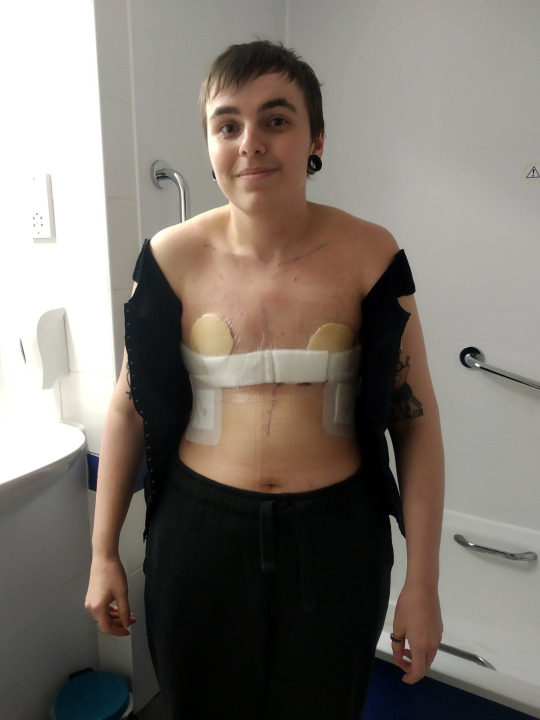
I was diagnosed with gender dysphoria (which is necessary in the UK for surgery) around May 2020 and started testosterone February 2021, all through GenderCare. I got a letter from the gender therapist and a surgery referral from GenderGP and consulted with my surgeon then booked surgery for 14th Feb 2022.


I had to travel all the way to Manchester, on a coach that took many hours, and book a hotel. I raised surgery money via GoFundMe because despite being referred to (now closing) Tavistock GIC in early 2020, my appointment to even be assessed wouldn't have been for over 5 years.
I had a double incision top surgery (double mastectomy) on February 14th 2022 as scheduled! I woke up in a fairly minor amount of pain, still on painkillers from the surgery, with drains. As you can see, I was also so happy that probably made it hurt less!
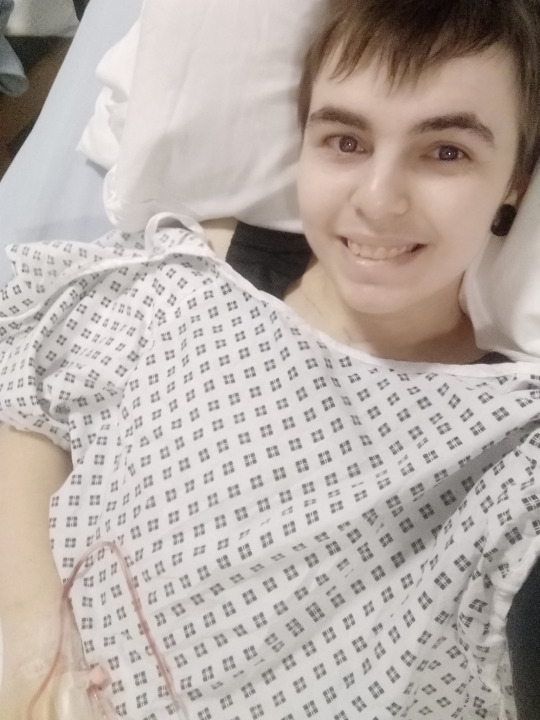
My top surgery took a few hours. Pre-surgery, my chest size was a 32 H. That's a lot of tissue to be removing, and so I did end up with drains for the first 48 hours after surgery, though drains aren't used as broadly in the UK anymore and not by default.
I was discharged from the hospital the morning after my surgery (some people go home the day of, but I pre-arranged to stay overnight). I took no painkillers after surgery at any point during healing. I was up and walking around from the moment I left!
If you take painkillers, that may make you more fatigued and/or constipated, so those things are totally normal. If you need painkillers, you should absolutely take them - it's not a point of pride to suffer more than you need to. I didn't take any painkillers because I have a history of addiction to them. However, I found the pain entirely tolerable even despite the lack of medication.
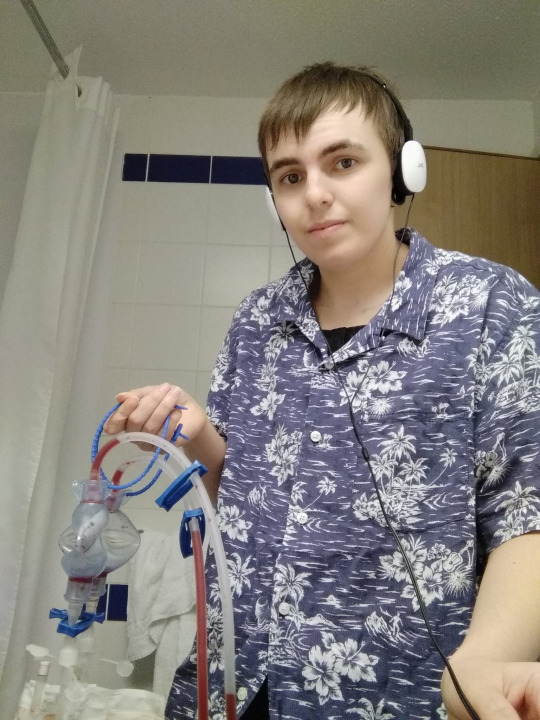

The evening after I was released from the hospital, I was pacing my hotel room carrying my drains! Moving promotes healing and prevents blood clots. I was very hunched!



Directly after surgery I got to briefly see my chest, but not for long given that I needed to have the compression vest on! I didn't have too much swelling, so I could see what my chest actually looked like and was so excited. Once I got my drains out, I got to see it for longer!
The pain post-surgery was manageable. I had to bend forwards a little when walking so as not to pull on my stitches and make it hurt more, but I never took any painkillers and the pain was never intense enough to make me feel compelled to. I kept wearing my compression vest!
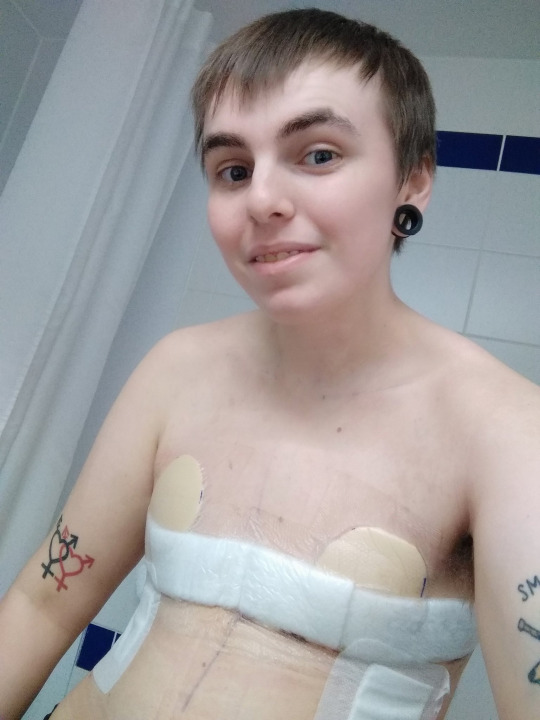

The drains were honestly the most painful part of the experience for me, and once they were out the most pain I felt was from my back from walking hunched forward. I wore the compression vest on and off for 2 weeks then abandoned it completely, because I had such little swelling.
3 weeks after surgery, I got my dressings off (except nipples). I could see the full scar. I told my surgeon I wanted scars that were mostly straight, and that combined with the size of my chest meant the scars needed to meet in the middle in a little triangle.
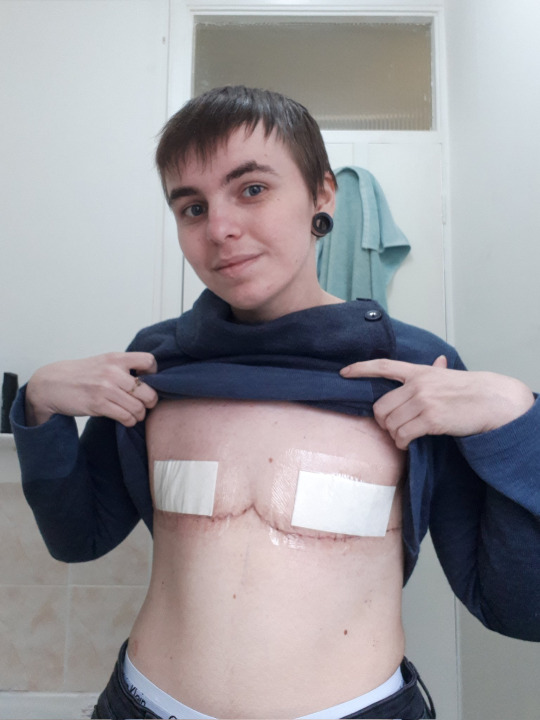
Everyone's scar shape is different, and you should talk to your surgeon about what you want. I didn't want semi-circle shape scars, because I wanted the scar to follow my pectorals so I'd have the option in the long-term of fading/medical tattooing and mostly hiding the scar.
3 weeks after top surgery, I was well-healed enough that I went into London for the Sex Work Strike and did a speech there! I was well-recovered by this point, though still fatigued. (A link to my speech if you're interested.)

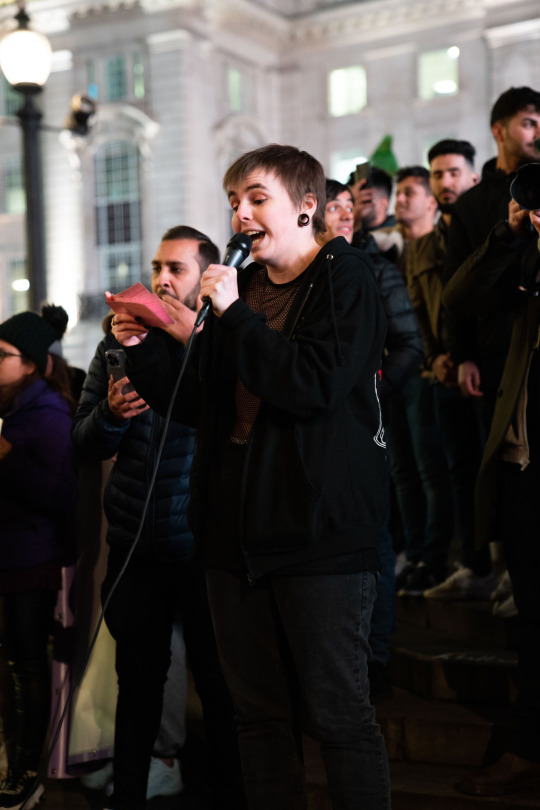
Around a month, I took off the nipple dressing as instructed by my post-op nurse, and one was healed enough for no dressing but the other took about another week to be as healed. Healing isn't perfectly symmetrical.
Once all of my dressings were off and I was able to probably clean my nipples and scars, I got to see the full result of my chest. This is the thinnest my scars ever were, because they hadn't developed as scars yet - they were healed shut but weren't done scarring.

Once I was past a month of healing, all of the physical effects of top surgery had dissipated. I was no longer fatigued, my scars didn't hurt (though they did itch!), and I was in the secondary healing phase. My chest below the top of the nipple had minimal sensation.
I got phantom sensations, like water being poured over my chest, as the nerves reconnected. It wasn't painful, but it was weird! By month 2, I regained full sensation in most of my chest, with very little sensation on the scar and the skin directly between it and my nipples.
I have pretty much full sensation (including erotic sensation) in my nipples now. It's important to note: double incision almost always results in some loss of sensation, especially in the nipples. I'd have been fine with that, and this was an extra bonus for me!
This is my chest and scars 8 months after surgery.

And this is my chest now, just over 2 years after top surgery:
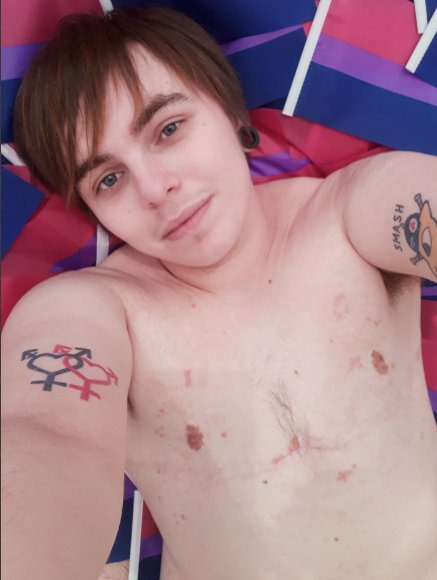
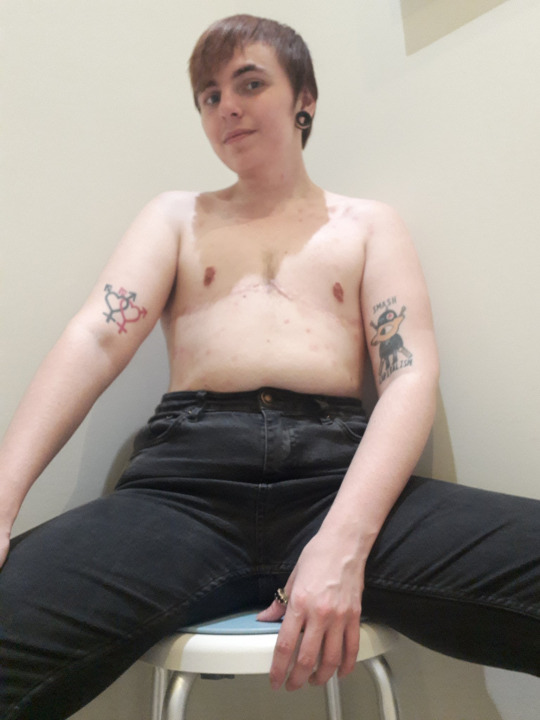
I'm very happy with how it looks, with how it feels, and I have zero regrets!
64 notes
·
View notes
Text
When Ritchie Herron woke after gender reassignment surgery, he had a feeling he had made a terrible mistake.
Five years later, his scars still sometimes weep and he cannot walk long distances or ride a bike. “I’ve awakened from what was a mental health crisis, to a body that will be for ever changed and damaged,” he said. He no longer identifies as transgender and is living as a gay man “as best I can, given what has happened”.
Now, the Newcastle-based civil servant, 36, has launched legal action against NHS England, alongside the “heartbroken” father of a 21-year-old who has been booked in for imminent genital-removal surgery at an adult gender clinic. The two men are demanding a judicial review which includes an independent inquiry into the safety of NHS treatments being offered to young people under the age of 25 who are experiencing gender dysphoria.
Steve Barclay, secretary of state for health, and Kemi Badenoch, minister for equalities, as well as Dr Hilary Cass, who carried out a recent review of the Tavistock Gender Identity Development Service (Gids) are also being served with legal papers. The father is hoping to stop the surgery from going ahead.
In a crowdfunding appeal to raise funds for their legal case, launched today, Herron and the father, who wishes to remain anonymous, say that the model of care for gender dysphoria in the NHS adult service is “profoundly unsafe” and “routinely places young people on a pathway towards irreversible lifelong treatment”.
Both Herron and the father’s 21-year-old child have been diagnosed as autistic. According to lawyers representing the two men, the NHS may be discriminating against autistic people, who are disproportionately more likely to be treated in the gender clinics, which is why Badenoch, as minister for equalities, is included in the legal action.
The case comes as a large number of 17-year-olds who have been on the 8,000-strong waiting list of the Tavistock clinic in north London, England’s only NHS gender identity clinic for children, are being referred to the adult service.
At the seven NHS adult gender clinics in England and Wales, surgery and cross-sex hormones are offered after the age of 18. Patients have at least two assessment appointments with a specialist medical practitioner before hormone treatment is recommended, and those who are considering surgical treatment have two further meetings with separate clinical professionals before they are referred.
There has been a sharp rise in the past decade in young people wanting to change gender. From 2011-12 to 2021-22, the number of under-18s in England referred to the Tavistock soared from 210 to 3,585, according to its own figures.
Herron was 25 when he decided he was a woman living in a man’s body. He had been bullied at school and struggled to cope with his parents’ divorce, and was diagnosed in his early 20s with depression and obsessive-compulsive disorder (OCD).
He decided he was transgender and “all my struggles were due to gender dysphoria” — an idea he says was encouraged by older activists in internet forums. He fixated on the idea that “my body was being poisoned by testosterone”, he says.
In 2013, he was referred by his GP to an NHS adult gender clinic, and says he was asked early on by an NHS clinician if he had considered gender reassignment surgery. He attended a private clinic as there was a long NHS waiting list, where he was diagnosed as transgender.
When he was seen by the NHS clinic in 2014, they prescribed testosterone blocker and later oestrogen. He also started therapy with an NHS psychosexual counsellor, which lasted for 100 sessions over five years, after which he was told he would be discharged and that the only other treatment open to him was surgery. He had delayed and cancelled the irreversible operation, which involves removing the penis and testicles and modelling the area to resemble female genitalia, several times over the previous two years, fearing the consequences.
In 2017, he was given another referral for surgery, to be performed at a private hospital but paid for by the NHS.
Finally, in 2018, “two days before my 31st birthday, I underwent a surgery that removed my genitals, inverting them in a procedure that has been marked as refined, but is no more civilised than an amputation” he said.
“Today, despite multiple follow-up surgeries, my scar lines still weep, occasionally becoming inflamed and causing crippling pain. In the flesh cavity that was created to mimic a vagina, I feel mostly nothing, aside from the occasional stabs of pain. I can’t use the toilet properly . . . and no matter how hard I push or strain, a dribble emerges, which may continue for hours after I have left the seat.”
The father who, with Herron, is seeking a judicial review of the adult services, says he is terrified of the possible outcome for his child, who was born a boy and who is due to undergo genital surgery shortly. The young person “is on the autistic spectrum, suffers from anxiety and has very poor mental health”, according to the father. The father believes that, like Herron, they think “becoming a woman will solve so many of his problems”.
“I am one of the many parents who is heartbroken over the journey my son has taken,” said the father, who is paying towards the legal fees for the case. “I know he has been let down by the system and fear for his future.”
Aged 13, the boy, who had struggled at school, “out of the blue” told an NHS child mental health adviser that he believed he was a girl. “He was referred to an NHS clinic and was prescribed puberty blocking drugs to halt his development as soon as he turned 16. I was shocked that such an experimental treatment would be given, despite my objections. His anxiety and his autism were not explored.
“I decided to try to prevent him attending the NHS clinic but was threatened with the possibility of him being taken into care if I stood in his way.
“As a parent, I am deeply concerned to protect my son. I am shut out,” he said. “A system with such limited safeguards, providing a radical experimental treatment with life-long consequences is structurally unfair to people like my son, whose autism makes him more likely to seek the answer to his problems in this radical treatment. He needs more protection, not less.”
The men are being represented by the legal team that helped another de-transitioner, Keira Bell, win a High Court case against Gids to stop children with gender dysphoria being prescribed puberty-blocking drugs. Bell was given the drugs to stop her development aged 16, before later, at an adult clinic, being referred for a double mastectomy. The case was later overturned at the Court of Appeal but led to a critical review of Gids by Dr Hilary Cass. Gids has since been earmarked for closure, although this has been delayed until March 2024, about a year later than first planned.
Herron was not diagnosed with autism until this year, but says he raised the condition with the NHS gender clinic. He adds that if he had received a comprehensive psychological assessment and treatment for conditions such as autism and OCD at the outset, he would never have undergone genital surgery. “I can deal with my own regret, and my own stupidity, but I can’t deal with the fact that I’m not alone in this. That there are not just dozens, or hundreds, but thousands of others like me, and more to come.
“We deserve a safety net, we deserve to be challenged in our beliefs before we make irreversible decisions that have huge lifelong consequences, we deserve to be caught and cared for. We do not deserve to be punished for asking for help, by being castrated and gaslighted into a way of thinking that isn’t our own.
“It is a matter of urgency that the treatment offered by adult services is reviewed and that safeguards are put in place.”
185 notes
·
View notes
Text
London Memories - A three days story
As my moots and my friends know, I've been in a bad place lately, mentally and physically, and last Friday, I exploded.
Now, after many many hours of conversation and a therapy session, I have experienced what they call a 'depression meltdown'. I'm not going to share the details mostly because I did not recall living through the events of that Friday. Everything went black and when I woke up the next day I found out I had planned, I mean flights, hotel, bus transfer from and to the airport and a theatre ticket, to London.
As my friends know, London is my HEIMAT. I've been there three times this year and yet the last fourth one was not actually planned as I imagined. I have to say tho that I did a great job in organising the three days and the events and everything. Also, it was not the perfect time for a trip but the 'damage' was already done so I decided to, I'd like to say 'embrace the moment and be happy' but, I cried till the day of the departure and when landed in London something happened.
My brain went quiet. I was starting to feel present again, like in the moment. I even put some music on. I hadn't been able to listen to music for at least a week or two before the meltdown. Not even to cope with external sensory issues.
I started to feel like me again. I could finally see myself, in the mirror, with my own eyes, through my crowded thoughts.
I was able to write! I began a story that I'd to see as a picture book.
In the hotel room, I actually find my space, mental and physical, to be me. I was able to take care of some other aspects of my life that I'm finding quite challenging in this period of time.
I took so many walks. The cold air was refreshing and 'cooled' down my brain. I definitively function much better there, that's a fact.
vaya chapa jaja I don't know how to translate that lol
I'd like to share here some happy moments cause WTF I actually saw David Tennant!
First of all the weather! I love gloomy days but this, this was a surprise! A pleasant welcome

The walks. My feet still hurt but I'm so happy!
I don't know if you ever visited this street but knowing that was an inspiration to Wickber Street in the series I understand why the Aziraphale chose this location for its bookshop. It's crowded with all sorts of people from all over the world. You can, and that's what I like to do, sit in a coffee shop and just observe them. Observe life passing by.

This was in Tavistock Square, IYKYK. Here I had a strange encounter with a squirrel. I was taking this picture when turning around I saw a little creature in front of me. We looked into each other eyes and the (silent) conversation was something down the line:
Human (aka me): oh shit! Sorry. Hi little you.
Little creature (aka the squirrel): Uh they so me. Ehm. Act normal.
Human (aka me): *moving to the left*
Little creature (aka the squirrel): *does the same*
Human (aka me): Oh sorry. *is this the most English thing I've ever experienced* *moving to the right*
Little creature (aka the squirrel): Oh shit. Act normal. Maybe I should stop staring at them. *moving to the right*
Human (aka me): Please, after you. *stop moving and gesturing with the hand to let the creature pass by*
Little creature (aka the squirrel): *keeps staring staringly* Ok this was strange. Bye human. *runs*
Human (aka me): That was odd! *walks away but then turns around*
Little creature (aka the squirrel): *does the same*
FIN
and they live happily ever after, I guess lol

This is Hyde Park. Walk kicking the leaves was a child's dream! I felt like a 5 yo. I had a second encounter with a squirrel that thought I had food in my hand but I just wanted to say hi, so they sniffed it and hopped away with their fluffy tail.

I love buses! They're the perfect decompression place for me and an optimal observation deck from which to admire the city. I spot this one outside the Peacock Theatre. I don't know what was it for but the words 'To Our World' came to my mind immediately.

The British Library. This is the place where I can write. This is the place for my stories to come alive, for my pen to dance on the pace, for my thoughts to be free to walk before my eyes and tell me what they want to experience. This is the place in which my brain goes quiet. Entering this place it's like having a wee free man in my head that finally decides that it's time to tidy up the room, organize their books, iron their kilt, rearrange the furniture for better comfort, light the fireplace, make some hot tea, bake some lemon biscuits and singing out of tone Scottish songs. That's how my brain felt there.
If you are wondering, my wee free man's hair is red as hell and up in a messy bun.

THE NIGHT aka Macbeth!
I still can't believe I saw David Tennant!

The play was amazing, from the cast to the minimalist stage, the music, the light. Everything was perfect!

I had the chance to just ramble and say thanks for the autograph!

A little video of the moment he signed my copy and me being absolutely out of my body.
The Harold Pinter Theatre was a special place!

and that's the end. The last pic. A magical place in which, every time, I make a promise to myself, to be present, to hold on to that dream, to be strong and to forgive myself when I'm not, to keep writing, to keep seeking help, to rest when possible and to take good care of the body I'm in.

Till the next adventure!
Bonus content, I guess.
I took this photo and is it me or this hand is the Duke of hell's hand? Hands lovers do with it what you like.

#random london trip#depression meltdown#good omens fandom places#the bench#crowley#aziraphale#the british library#the wee free man in my head is happy now#sort of#he's trying#macbeth#london#the harold pinter theatre#what a play#I loved every moment of it#incredible cast#london cultural scene#cold weather#british library#coffe shop#bookshop#berwick street#david tennant#to our world#michael sheen#good omens#ineffable husbands#autistic meltdown#autistic experience#writing about it
16 notes
·
View notes
Text
By: Helen Dale
Published: Apr 29, 2024
A new book raises tough questions about the history of gay liberation
Trans activism has caused bitter divisions within the gay rights movement
Medical professionals responding incorrectly to gender nonconformity has dire consequences
When scriptwriter Gareth Roberts was 14, he called a helpline promoted by a new organisation, one dedicated to helping gay and lesbian youth. The operator tried to set him up on a date with a 19-year-old. Fortunately, the young Roberts had the wit to realise this ‘was a very bad idea’.
A related organisation opened the first – and, at the time, only gay youth club in the country. Roberts joined, only to discover meeting rooms and communal areas littered with literature from PIE. That, for readers who aren’t gay or lesbian and of a certain vintage, stands for ‘Paedophile Information Exchange’.
What you need to understand – as Roberts argues in his first book, Gay Shame: The Rise of Gender Ideology and the New Homophobia – is ‘that there was a prominent streak of gay activism that was absolutely insane’. And, despite major successes borne of both a mature response to the AIDS crisis and opposition to Section 28, the bonkers quality never went away. That said, he admits he didn’t expect ‘the gay rights movement transmogrifying into a cross between the Church of Scientology, Heathers: the Musical and Act 4 of The Crucible’.
In Gay Shame, Roberts does two things. First, he explains how and why trans activism has become the ‘official’ gay rights movement that now (bitterly) divides gays and lesbians. It’s impossible not to notice the extent to which fights over trans issues often involve two opposed teams of homosexuals: Stonewall vs LGB Alliance. Roberts is a gay man and directs ordnance (for the most part) at gay men while also contextualising this division in an intelligent way. However, when feminist and lesbian adherents of the religion he calls ‘genderism’ cross his radar, they cop a similarly witty serve.
Secondly – and in a way that tracks the careful evidence-gathering of the Cass Review – he conveys the extent to which transgenderism represents ‘transing the gay away’. Most of the children who went through the Tavistock – 9,000 of them in all according to Cass – were same-sex attracted or simply gender nonconforming. Rising numbers, year-on-year, of glittery, swishy little boys and even more sporty but quirky little girls.
‘This is an ideology,’ Roberts points out in a coruscating passage, ‘that says there is something wrong with camp little boys and butch little girls and that they need to be fixed’.
This is impressive despite its grimness. Gay Shame only came out last Thursday, and – due to typical lead-times in publishing – was written in 2023. Despite a stint as a writer for Dr Who, Roberts didn’t nick the Tardis and get early access to the Cass report. This care and foresight has the effect of forcing readers – both heterosexual and homosexual – to think about how we respond to gender nonconforming behaviour.
Most people do not understand what it’s like to be gender nonconforming or appreciate the extent to which gender nonconforming people stick out like sore thumbs. Gays, lesbians and bisexuals won social acceptance before everyone else properly ‘got’ us. Roberts’ hands must be a mess, because he grasps every bloody nettle on the gay male side of the equation: from the extent to which gay male sexuality is utterly unlike straight male sexuality (because it does not involve women) to taking aim at a string of overpraised, low-quality gay male contributions to popular culture.
Does that mean every gay man on the planet sleeps around and adores Eurovision? No, of course not, but there are also no lesbian chemsex parties and heterosexuals really don’t have to pretend Eurovision is bloody marvellous. Meanwhile, if a straight man wanted some sort of chemsex equivalent, it would involve handing over a lot of cash to a group of women he doesn’t know in icky bits of London he would prefer not to frequent.
This absence of theory of mind – common but not universal when dealing with people unlike oneself – has implications. In a discussion of what he concedes is ‘a small minority of gay men,’ Roberts observes how ‘the Metropolitan Police’s shockingly inept handling of the case of the serial rapist and murderer Stephen Port in London in 2014/15 was partly down to their assumptions about the chemsex deaths of gay men’.
Of value is Roberts’ account of what he calls ‘the fall of Stonewall’, which was, in retrospect, astonishingly swift. ‘You can literally narrow it down to about three weeks in late 2014,’ he told me last week. He documents the extent to which Stonewall’s pivot to trans activism arose in part because it fell for queer theory (‘peer review is the process by which academics mark each other’s homework,’ he observes, tartly) and partly because it had won. ‘What was Stonewall for?’ Roberts asks. ‘It had no active political campaigns left to fight in the UK. But it had a huge staff, and a massive engine room of fundraising and campaigning machinery. A tender full of coal and no track��.
One effect of Stonewall’s pivot – and later persecution, along with Mermaids, of the LGB Alliance – was that the latter organisation spent years fighting off attacks on its charitable status, unable to do much else. Only recently has it been able to work normally, ‘doing,’ as Roberts says, ‘exactly the same work as Stonewall did before its fall to genderism’.
Gay Shame raises all sorts of difficult questions. It’s really striking, for example, what a recurrent feature the sexualising of children is within allegedly ‘liberatory’ streams of thought. This manifests in something Roberts calls ‘The Leap’. The Leap consists of the belief that ‘people (including, incredibly, children) are always what they claim to be, rather than what they are’.
Roberts’ discussion of gay men and gay male sexuality – and of male and female gender nonconformity more widely – also serves to remind the rest of us that we know very little about homosexuality. I know loads of ‘right-on’ straight parents who bought their son girl toys or their daughter boy toys. The kids simply blew them off. This, I’m afraid, is because most children are gender conforming. Gender has biological roots: the stereotyped behaviours it produces mean that deviations are really going to show. The thing is, gender nonconforming behaviour and the homosexuality and bisexuality that often accompany it also have biological roots, but we don’t know why.
In biology, a spandrel is a phenotypic trait that’s a by-product of some other evolved characteristic, rather than a direct product of adaptive selection. It’s a term borrowed from cathedral architecture, where it refers to something decorative, but which provides no structural support. Maybe some homosexuals don’t mind the idea that we’re just the fancy bit at the corner of an arch, but we’re too common to be an evolutionary spandrel. We exist for a reason. Why would evolution throw up a group of people of both sexes who are attracted to their own sex? Not exactly going to contribute to reproducing the species, are we?
Gareth Roberts isn’t sure that ‘genderism’ will collapse. At the end of Gay Shame, he presents two plausible scenarios. One depicts a world where queer theory and all its works and all its ways has gone down the long slide and all seems well. The other shows what things look like in the event of a genderist win. And in that world, the grim joke that emerged among staff at the Tavistock has come true. There are no gay people left.
#Helen Dale#Gareth Roberts#homosexuality#bisexuality#gay conversion therapy#gay conversion#gay rights#genderism#gender ideology#gender identity ideology#gay not queer#queer theory#intersectional feminism#gender nonconforming#gender non conforming#trans the gay away#medical scandal#medical corruption#religion is a mental illness
10 notes
·
View notes
Text
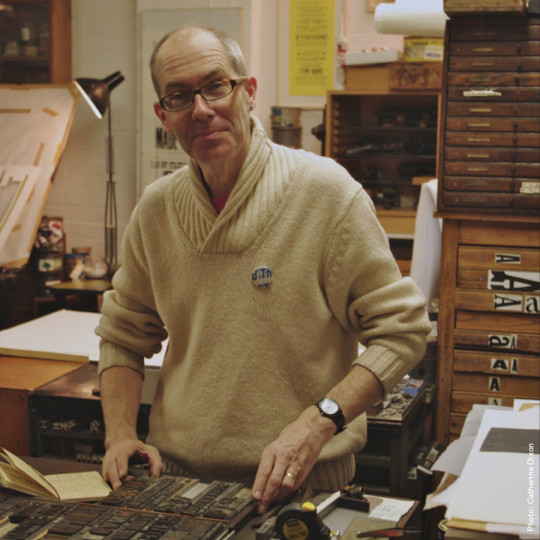
Phil Baines, who has died aged 65 of multiple system atrophy, was one of the most distinctive voices in contemporary British graphic design. His work included books, posters, art catalogues and lettering for three important London monuments – the memorial to the Indian Ocean tsunami in the grounds of the Natural History Museum and the 7 July memorials in Hyde Park and Tavistock Square, commemorating the victims of the 2005 London bombings. These projects point to Baines’s defining attributes: a scholarly appreciation of letterforms, a deep-rooted respect for materials and a love of collaboration.
Such attributes can also be seen in Baines’s cover designs for the Penguin Great Ideas series (2004-20), works by “great thinkers, pioneers, radicals and visionaries” that gave him a canvas on which to display his typographic philosophy. The Saint Augustine – Confessions of a Sinner cover, for instance, uses ancient ecclesiastical letterforms and yet looks superbly modern. For Chuang Tzu — The Tao of Nature, Baines arranged letters to suggest a butterfly in flight. David Pearson, one of two art directors for the series, described how his “often-oblique approach gave the series a crucial added dimension”.
Born in Kendal, Cumbria, Phil was one of the three children of Martin Baines, a construction contract manager, and Joan (nee Quarmby), a horticulturalist. Growing up in a Roman Catholic household, he began studies for the priesthood at Ushaw College, County Durham. During the holidays from Ushaw he worked at the Guild of Lakeland Craftsmen, Windermere, and from there his interest and confidence in art grew.
At the start of his fourth year, he quit Ushaw, and in 1980 began a year’s study on the foundation course at Cumbria College of Art and Design. In 1982 he moved to London and enrolled on the graphic design course at St Martin’s School of Art (now Central Saint Martins), where he met Jackie Warner, whom he married in 1989, and where he was among a talented cohort, many of whom went on to study, as he did, at the Royal College of Art.
Richard Doust, then leader of the first-year course at St Martins, recalled the portfolio Baines submitted for admission: “I was so excited … I was sure he was going to be someone very special. He quickly established his individuality. He made typography and particularly letterpress his own territory.”
Baines was fiercely individual – he did not join schools of thought or align himself with fashionable camps. Instead, he built a creative practice based on his belief in the “humanist” qualities of the English typographic tradition.
His contemporaries were using the computer to bring a new complexity to graphic communication. Smart software allowed for the overlapping and interweaving of text in ways that echoed the ecclesiastical manuscripts that Baines admired so much. He was no Luddite, and used the computer himself, yet his work invariably retained an element of the handmade.
Paradoxically, his work was greatly admired by the new generation of digital designers. Neville Brody, for instance, included Baines’s work in his experimental typography publication FUSE, produced to demonstrate the malleability of the new digital typography. Baines’s work does not look out of place among the other contributors, many of them American typography radicals whose multi-layered layouts were driven by modish theories of deconstruction and poststructuralism.
In 1988 he returned to Central Saint Martins (CSM), as part of the faculty. In staff meetings his willingness to say the unsayable was a frequent cause for consternation among colleagues. To his students he preached a doctrine of “object-based learning”, a typically contrarian notion in the age of screen-based and virtual graphic design. He was appointed a professor in 2006 and retired in 2020 as emeritus professor.
Despite his commitment to teaching, Baines did not give up his work for clients. As well as designing books for leading publishers, he worked for the Crafts Council and the Ditchling Museum of Art + Craft, and designed the signage for CSM’s King’s Cross campus. He designed exhibition catalogues for Matt’s Gallery, south-west London, relishing the creative three-way collaboration that existed between the gallery’s director, Robin Klassnik, exhibiting artists and himself.
He wrote books that contributed to the understanding of visual communication: Type & Typography (with Andrew Haslam, 2002), Signs: Lettering in the Environment (with Catherine Dixon, 2003) and Penguin by Design: A Cover Story 1935-2005 (2005), the last of which helped establish Penguin cover art as one of the most important bodies of graphic art in British design history.
With Dixon, he co-curated the Central Lettering Record, an archive of typographic history housed at CSM, and in November 2023 his work was celebrated in an exhibition, Extol: Phil Baines Celebrating Letters, at the Lethaby gallery, CSM. He was appointed as the Royal Mint advisory committee’s lettering expert in 2016, and reappointed in 2021 to advise on the integration of lettering on new coins and medals, with consideration given to special issues and the accession of King Charles to the throne. For this work, in 2023 he was awarded the Coronation medal.
Baines was an enthusiastic runner and cyclist, and loved music, especially the Manchester post-punk band the Fall. He was a collector of signs, lettering, and railwayana, and built his own studios at his home in Willesden Green, north-west London. A few years before his retirement he moved to Great Paxton, Cambridgeshire, where he took up bellringing.
He is survived by Jackie and their two daughters, Beth and Felicity, and by his father.
🔔 Philip Andrew Baines, graphic designer, born 8 December 1958; died 19 December 2023
Daily inspiration. Discover more photos at Just for Books…?
9 notes
·
View notes
Text
Silver Blaze
This is the first published story in the Memoirs collection and the penultimate of the twelve that we will be looking at.
Doyle later admitted that the stuff about the horse racing wasn't the most accurate in the world.
London to Exeter was a train journey of around four hours on the fastest trains, although most took slightly longer. Today you can get there in around 2 hours and 20 minutes and 53 1/4 miles per hour would be considered slow for that route.
There is a section of train fiends who like to time journeys off mile posts and work out averages, generally on steam-hauled railtours.
Off-course betting on horse racing in person was illegal at this time - but it was not illegal for people in private clubs etc. to place bets with bookmakers via telegraph or telephone.
There was also a vast amount of illegal bookmaking going on, which the police frequently turned a blind eye to.
Tavistock is a small market town in Devon, whose most famous resident was the English privateer/pirate and explorer Sir Francis Drake, who became the first Englishman to circumnavigate the world in 1578-1581, while engaging in quite a bit of plundering against the Spanish on the way.
Both of Tavistock's railway stations and associated lines through Tavistock closed in the 1960s; there are proposals to reopen one of them as part of some new development.
Curry was becoming popular at this time - recipes could be found in Mrs. Beeton's Book of Household Management, published by the same man (her husband) who initially printed A Study in Scarlet in a Christmas annual.
Tallow, i.e. rendered animal fat, was commonly used for cheaper candles. They didn't smell very nice.
Pullman carriages in the UK were luxurious daytime carriages, often with a steward and at seat dining. There are still a couple of services in the UK that offer the last.
24 notes
·
View notes
Text
Hannah Barnes’s book about the rise and calamitous fall of the Gender Identity Development Service for children (Gids), a nationally commissioned unit at the Tavistock and Portman NHS Foundation Trust in north London, is the result of intensive work, carried out across several years. A journalist at the BBC’s Newsnight, Barnes has based her account on more than 100 hours of interviews with Gids’ clinicians, former patients, and other experts, many of whom are quoted by name. It comes with 59 pages of notes, plentiful well-scrutinised statistics, and it is scrupulous and fair-minded. Several of her interviewees say they are happy either with the treatment they received at Gids, or with its practices – and she, in turn, is content to let them speak.
Such a book cannot easily be dismissed. To do so, a person would not only have to be wilfully ignorant, they would also – to use the popular language of the day – need to be appallingly unkind. This is the story of the hurt caused to potentially hundreds of children since 2011, and perhaps before that. To shrug in the face of that story – to refuse to listen to the young transgender people whose treatment caused, among other things, severe depression, sexual dysfunction, osteoporosis and stunted growth, and whose many other problems were simply ignored – requires a callousness that would be far beyond my imagination were it not for the fact that, thanks to social media, I already know such stony-heartedness to be out there.
Gids, which opened in 1989, was established to provide talking therapies to young people who were questioning their gender identity (the Tavistock, under the aegis of which it operated from 1994, is a mental health trust). But the trigger for Barnes’s interest in the unit has its beginnings in 2005, when concerns were first raised by staff over the growing number of patient referrals to endocrinologists who would prescribe hormone blockers designed to delay puberty. Such medication was recommended only in the case of children aged 16 or over. By 2011, however, Barnes contends, it appeared to be the clinic’s raison d’etre. In that year, a child of 12 was on blockers. By 2016, a 10-year-old was taking them.
Clinicians at Gids insisted the effects of these drugs were reversible; that taking them would reduce the distress experienced by gender dysphoric children; and that there was no causality between starting hormone blockers and going on to take cross-sex hormones (the latter are taken by adults who want fully to transition). Unfortunately, none of these things were true. Such drugs do have severe side effects, and while the causality between blockers and cross-sex hormones cannot be proven – all the studies into them have been designed without a control group – 98% of children who take the first go on to take the latter. Most seriously of all, as Gids’ own research suggested, they do not appear to lead to any improvement in children’s psychological wellbeing.
So why did they continue to be prescribed? As referrals to Gids grew rapidly – in 2009, it had 97; by 2020, this figure was 2,500 – so did pressure on the service. Barnes found that the clinic – which employed an unusually high number of junior staff, to whom it offered no real training – no longer had much time for the psychological work (the talking therapies) of old. But something else was happening, too. Trans charities such as Mermaids were closely – too closely – involved with Gids. Such organisations vociferously encouraged the swift prescription of drugs. This now began to happen, on occasion, after only two consultations. Once a child was on blockers, they were rarely offered follow-up appointments. Gids did not keep in touch with its patients in the long term, or keep reliable data on outcomes.
A lot of this is already known, thanks largely to a number of whistleblowers. Last February, the paediatrician Dr Hilary Cass, commissioned by the NHS, issued a highly critical interim report into the service; in July, it was announced that Gids would close in 2023. But a lot of what Barnes tells us in Time to Think is far more disturbing than anything I’ve read before. Again and again, we watch as a child’s background, however disordered, and her mental health, however fragile, are ignored by teams now interested only in gender.
The statistics are horrifying. Less than 2% of children in the UK have an autism spectrum disorder; at Gids, more than a third of referrals presented with autistic traits. Clinicians also saw high numbers of children who had been sexually abused. But for the reader, it is the stories that Barnes recounts of individuals that speak loudest. The mother of one boy whose OCD was so severe he would leave his bedroom only to shower (he did this five times a day) suspected that his notions about gender had little to do with his distress. However, from the moment he was referred to the Tavistock, he was treated as if he were female and promised an endocrinology appointment. Her son, having finally rejected the treatment he was offered by Gids, now lives as a gay man.
As Barnes makes perfectly clear, this isn’t a culture war story. This is a medical scandal, the full consequences of which may only be understood in many years’ time. Among her interviewees is Dr Paul Moran, a consultant psychiatrist who now works in Ireland. A long career in gender medicine has taught Moran that, for some adults, transition can be a “fantastic thing”. Yet in 2019, he called for Gids’ assessments of Irish children (the country does not have its own clinic for young people) to be immediately terminated, so convinced was he that its processes were “unsafe”. The be-kind brigade might also like to consider the role money played in the rise of Gids. By 2020-21, the clinic accounted for a quarter of the trust’s income.
But this isn’t to say that ideology wasn’t also in the air. Another of Barnes’s interviewees is Dr Kirsty Entwistle, an experienced clinical psychologist. When she got a job at Gids’ Leeds outpost, she told her new colleagues she didn’t have a gender identity. “I’m just female,” she said. This, she was informed, was transphobic. Barnes is rightly reluctant to ascribe the Gids culture primarily to ideology, but nevertheless, many of the clinicians she interviewed used the same word to describe it: mad.
And who can blame them? After more than 370 pages, I began to feel half mad myself. At times, the world Barnes describes, with its genitalia fashioned from colons and its fierce culture of omertà, feels like some dystopian novel. But it isn’t, of course. It really happened, and she has worked bravely and unstintingly to expose it. This is what journalism is for.
22 notes
·
View notes